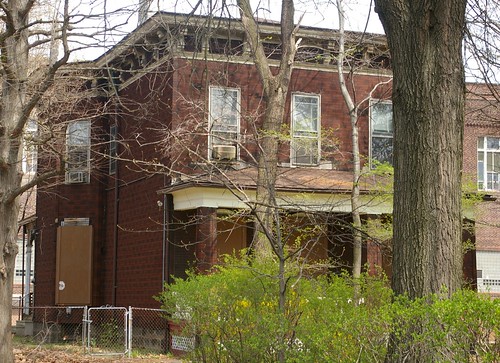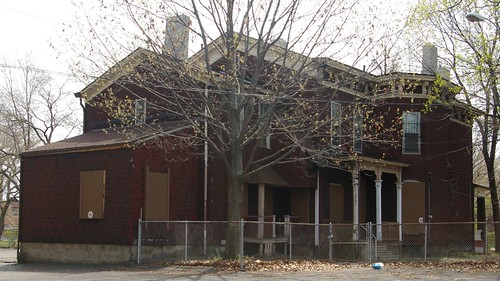
The Diocese of Cleveland has closed many churches in the greater Cleveland area in recent years. As you may have heard, they are now listed for sale. One of the more interesting properties, as I see it, is this one, St. George's Lithuanian Church and School, at 6527 Superior Avenue, in Cleveland, Ohio.
For $175,000, you get the church/school, rectory, and a 4+ car garage which sit on a 2.73 acre lot. According to the Cleveland Architects Database, the church was designed by architect J. Ellsworth Potter, in 1920. Potter specialized in churches, and built several in the Cleveland area, including Sacred Heart of Jesus Church on East 71st Street. The website for the church provides some history of the congregation. It indicates that it was the oldest functioning Lithuanian Parish in North America.
The church / school structure features a sanctuary on the upper level and classrooms on the lower levels. It's an interesting building with some nice architectural details, but isn't so ornate that it would be difficult to use for something other than a church. This website has several historical photos of the exterior of the church, including some made during the construction, which might help illustrate the history of this structure.

The rectory, to my eyes, is just as interesting as the church. The Italianate-style structure was built between 1874 and 1881 by Henry and Catherine Beckenbach. It remained in the family until 1917, when it was purchased by the Diocese of Cleveland. It is a wood framed structure with asphalt shingles that resemble brick covering the exterior. It is 4600 square feet, with seven bedrooms.

The front porch, shown in the first photo of the house, was added later, probably in the 1920s. The 1912 Sanborn fire insurance map shows a small porch, about half the width of the front house. This porch would have been of a similar style to that of the side porch. The map also illustrates a two story barn to the rear of the house and a henhouse.

I'm also reasonably confident that the small side porch shown here was originally similar to the one shown in the photo immediately preceding this one. Further, it appears to retain many of the original 2 over 2 windows.

This house has real potential. Look at its neighbor, just across the street for some ideas as to what might this one might look like with a bit of work. This represents a rare opportunity to obtain a house of this age with the full parcel of land that it was originally built on. The house appears to have been used until relatively recently, so is likely in reasonably solid condition. I suspect that the house hasn't been subjected to the numerous renovations over the years that a privately owned house might have had. As such, it should retain quite a bit of historic detail.
View St. George's Church and the Beckenbach residence in a larger map
This map illustrates the property in question and the extant buildings. The church is green, the house yellow, and the garage blue. The biggest problem, as I see it, is creating a plan that allows for practical reuse of both the house and the church. It might be a bit easier with the adjoining parcel on Superior, which is privately owned.
These are two great properties on a good chunk of land. They're solid structures, each from its own period, with its own stories. The siting of the two isn't exactly sympathetic to each other, but I know that someone out there can come up with a great way to use both of them, together.




the church looks a ton like the Lithuanian church in detroit! love your blog
ReplyDeletehttp://maps.google.com/maps?f=q&source=s_q&hl=en&geocode=&q=3564+Vernor+Highway,+detroit,+mi&sll=42.323407,-83.087816&sspn=0.001126,0.003433&ie=UTF8&hq=&hnear=3564+W+Vernor+Hwy,+Detroit,+Wayne,+Michigan+48216&ll=42.323495,-83.087598&spn=0.000242,0.001717&t=h&z=20&layer=c&cbll=42.323495,-83.087598&panoid=uuP0sq7lHVN9sukW4zLICg&cbp=12,202.53,,0,-20.36
Interesting. Perhaps Potter designed that one, too. He did have a couple of offices outside the Cleveland area.
ReplyDeleteHenry and Catherine were my great grandparents. As a boy my parents would drive by the house on Superior. There was a large carriage stone by the curb with the name "Beckenbach" carved into it. unfortunately it was just to big to dig up and salvage. Thanks for the story.
ReplyDeleteWow. Do you have any old family photos of the house? It'd be really interesting to see them, and I'm sure that they'd be of help to anyone wanting to fix up the house.
ReplyDeleteThis was my family's parish. I lived next door to the house in this article for 8 years. My family owned the house that was on the parcel next to the house in this article. Our house was sold in 1979. The new owner demolished the house (in an effort to not pay taxes?). Which accounts for the empty land next to the former priest's rectory house. If you buy in this neighborhood, you risk your life. This neighborhood now borders on the ghetto. High crime. Good friend was gunned down in the street in 1978. That's why the whole parish fled this neighborhood.
ReplyDeleteCommunity Greenhouse Partners bought the St George Parish Property in December of 2010. It is our intent to transform it into a hub for the local food movement and production. We would appreciate any help in documenting the history of the place. This would also help advocates of restoration with their case.
ReplyDeleteVisit our website: www.communitygreenhousepartners.org
or email tim@timroff.com
I don't believe that J. Ellsworth Potter was the builder of the "entire" church building. There is a possibility that the front of the 1380 East 67th building was added on in 1920-- it is possible that section of the building was done by J. Ellsworth Potter -- yes. But my research on George Samuel King has him building a Clubhouse for the Lithuanian Society on the same site in 1917. I believe that the Lithuanians ran out of money and decided to turn their Clubhouse into a Church, so they hired a church architect to make adjustments to King's work.
ReplyDelete